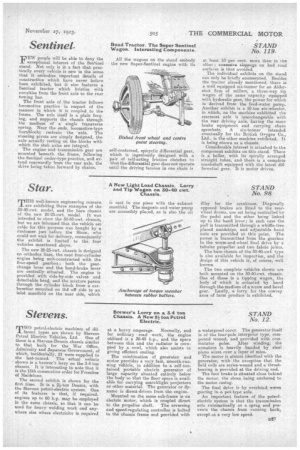Sentinel.
Page 31

If you've noticed an error in this article please click here to report it so we can fix it.
Road Tractor. The Super Sentinel Wagon. Interesting Components.
' STAND No. 119.
F' people will be able to deny the exceptional interest of the Sentinel stand. Not only is it a fact that practically every vehicle is new in the sense that it embodies, important details of construction which have never before been exhibited, but it also features a Sentinel tractor which bristles with novelties from the front axle to the rear towing bar.
The front a.xle of the tractor follows locomotive practice in respect of the manner in which it is coupled to the frame.. The axle itself is a plain forging, and supports the chassis through the medium of a single transverse spring. Near the ends, locomotive-type hornblocks restrain the axle. The steering pivots are simply designed, the axle actually resting on the blocks with which the stub axles are integral. The engine and transmission gear are mounted beneath the frame, following the Sentinel under-type practice, and extend rearwardly from the rear axle, the drive being taken forward by chains. All the wagons on the stand embody the new Super-Sentinel engine with its self-contained, epicyclic differential gear, which is ingeniously designed with a pair of self-acting friction clutches so that the differential gear does not operate until the driving tension in one chain is at least 10 per cent, more than in the other; exsessive slippage on bad road surfaces is thus avoided.
The individual exhibits on the stand can only be briefly enumerated. Besides the tractor already mentioned, these is a well equipped six-tonner for an Aldershot firm of millers, a three-way tip wagon of the same "capacity equipped with hydraulic gear, the power for which is derived from the feed-water pump. Another exhibit is a 10-ton six-wheeler, in which, on the machine exhibited the rearmost axle is interchangeable with the rear driving axle, having tho same brake equipment and carrying chain sprockets. A six-tonner intended eventually for the British (Dugan Co., Ltd., is the other machine exhibited. It is being shown as a chassis.
Considerable interest is attached to the component exhibits on this stand. There is a boiler, with its spirally arranged straight tubes, and there is a complete crankshaft equipped with the latest differential gear. It is motor driven.








































































